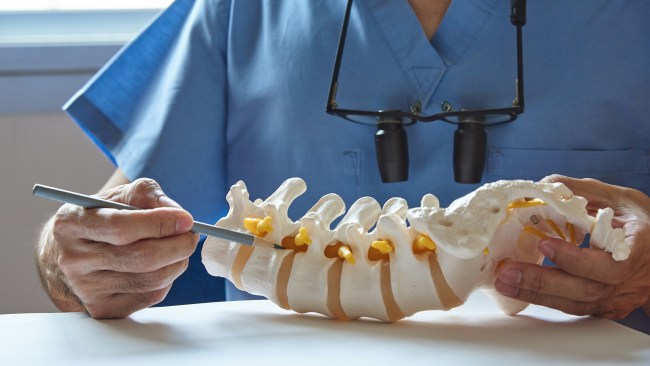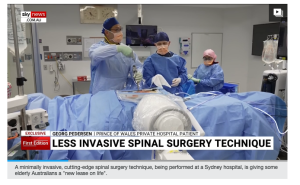Professor Ralph Mobbs hails 'Band-aid back surgery' with new technique set to improve thousands of Australians' lives.
A new technique, known as "Band-aid back surgery", is being hailed for significantly improving the quality of care for those suffering spinal conditions, with one surgeon hoping thousands of Australians could soon benefit from the treatment.
You can watch the insert here:
A new technique, known as "Band-aid back surgery", is being hailed for significantly improving the quality of care for those suffering spinal conditions.
The procedure, which is formally referred to as an endoscopic laminectomy, allows surgeons to remove part of the patient's spine in order to relieve pressure on the spinal cord or nerves.
Most laminectomies are conducted after more conservative treatments - such as medicines, physical therapy or injections - fail to provide results, as the procedure can result in significant pain during recovery and impair the movement of some patients for months.

However, according to Professor Ralph Mobbs the utilisation of an endoscope, a small camera attached to a length of cord, has "revolutionised" the procedure, significantly improving quality of care.
"The endoscopy has revolutionised women's surgery, abdominal surgery, prostate surgery, and we're now seeing that transition into the spine," he told Sky News Australia.
"Most patients are pleasantly surprised.
"They have chatted with their friends, they've heard horror stories about months of long recovery and they've had an intervention from which they return a week or two later and they say 'you know, I didn't have much pain here, I'm back doing pretty much everything I want to be doing and more'."
The hospital began investing in the surgery around four years ago in the hope of improving outcomes for those suffering spinal conditions.
Along with colleagues, Professor Mobbs performs up to 15 "Band-aid" back surgeries each week and helps to train other surgeons in the technique.
"At the moment there's around about 10 surgeons (who can perform the procedure) across Australia," he said.
"However, that number is increasing rapidly as the benefits are pretty obvious."
One such benefactor is cellist Georg Pedersen, who reported a remarkable improvement in his chronic back pain following the operation.
"I couldn't believe it when I woke up after the operation, there was absolutely no pain, of any kind, anywhere," he told Sky News Australia.

"I can do everything I want now, play the cello, walk to everything, so, it just gave me a new lease on life."
Thousands of Australians could be set to benefit from the surgery in the years to come, with the procedure commonly used to treat those suffering from spinal stenosis, bone spurs and bulging discs.
As with any medical procedure, the operation does carry risks, with Professor Mobbs advising those suffering from spinal conditions to first consult a specialist before making a decision to undergo surgery.
A new technique, known as "Band-aid back surgery", is being hailed for significantly improving the quality of care for those suffering spinal conditions.
The procedure, which is formally referred to as an endoscopic laminectomy, allows surgeons to remove part of the patient's spine in order to relieve pressure on the spinal cord or nerves.
Most laminectomies are conducted after more conservative treatments - such as medicines, physical therapy or injections - fail to provide results, as the procedure can result in significant pain during recovery and impair the movement of some patients for months.
However, according to Professor Ralph Mobbs the utilisation of an endoscope, a small camera attached to a length of cord, has "revolutionised" the procedure, significantly improving quality of care.
"The endoscopy has revolutionised women's surgery, abdominal surgery, prostate surgery, and we're now seeing that transition into the spine," he told Sky News Australia.
"Most patients are pleasantly surprised.
"They have chatted with their friends, they've heard horror stories about months of long recovery and they've had an intervention from which they return a week or two later and they say 'you know, I didn't have much pain here, I'm back doing pretty much everything I want to be doing and more'."

Professor Mobbs has led the way in use of the operation in Australia, making the most of support from the Prince of Wales Private Hospital in Sydney.
The hospital began investing in the surgery around four years ago in the hope of improving outcomes for those suffering spinal conditions.
Along with colleagues, Professor Mobbs performs up to 15 "Band-aid" back surgeries each week and helps to train other surgeons in the technique.
"At the moment there's around about 10 surgeons (who can perform the procedure) across Australia," he said.
"However, that number is increasing rapidly as the benefits are pretty obvious."
One such benefactor is cellist Georg Pedersen, who reported a remarkable improvement in his chronic back pain following the operation.
"I couldn't believe it when I woke up after the operation, there was absolutely no pain, of any kind, anywhere," he told Sky News Australia.
Cellist Georg Pedersen reported a remarkable improvement in his chronic back pain following the operation. Picture: Sky News Australia
"I can do everything I want now, play the cello, walk to everything, so, it just gave me a new lease on life."
Thousands of Australians could be set to benefit from the surgery in the years to come, with the procedure commonly used to treat those suffering from spinal stenosis, bone spurs and bulging discs.
As with any medical procedure, the operation does carry risks, with Professor Mobbs advising those suffering from spinal conditions to first consult a specialist before making a decision to undergo surgery.
If you think "Band-Aid Back Surgery" is for you, then it may be time to contact the team at Endospine.
